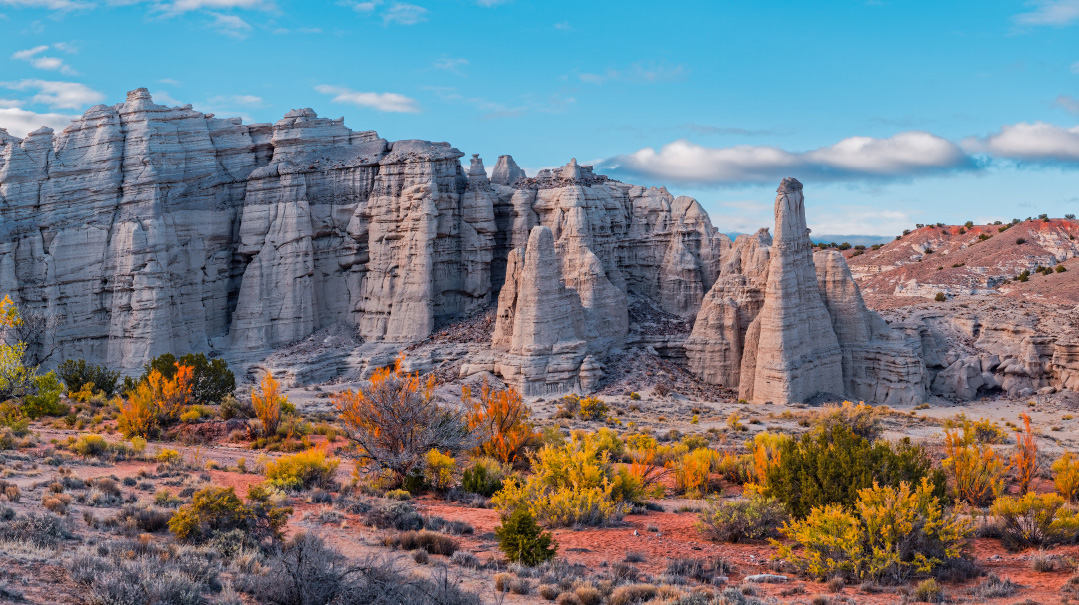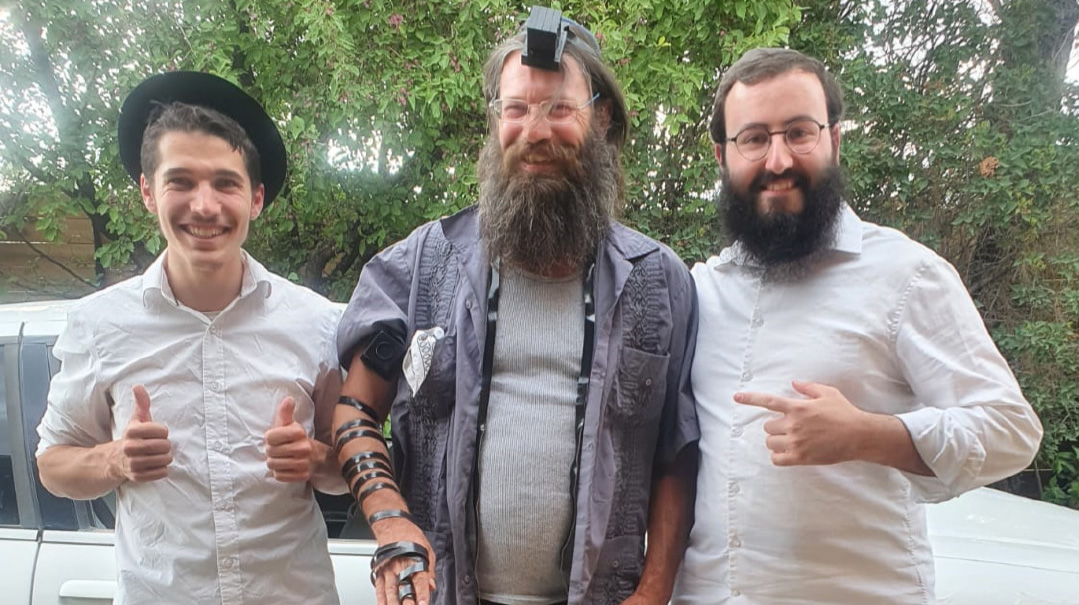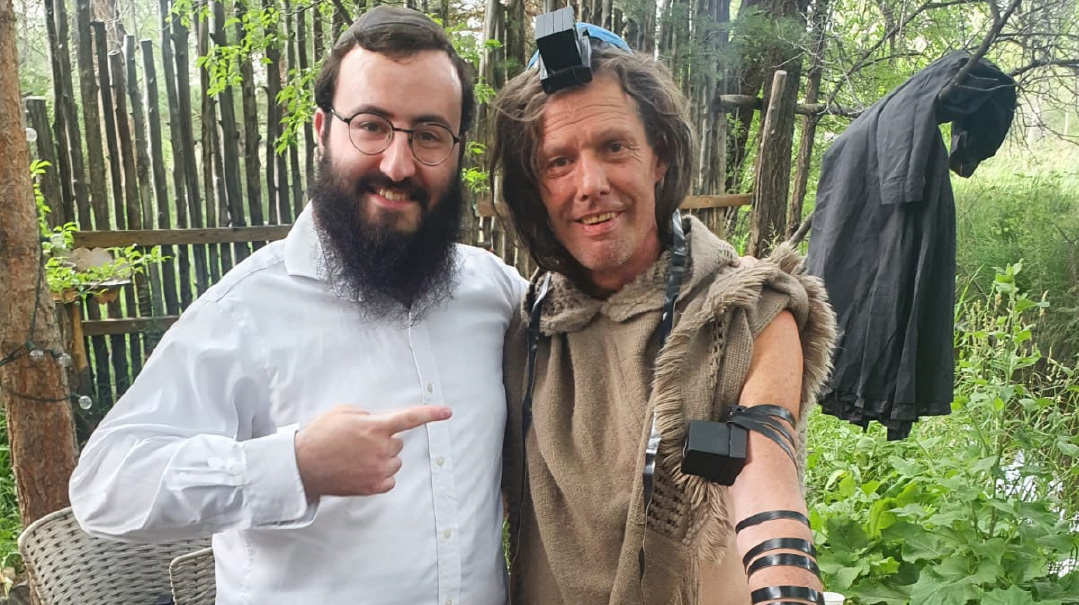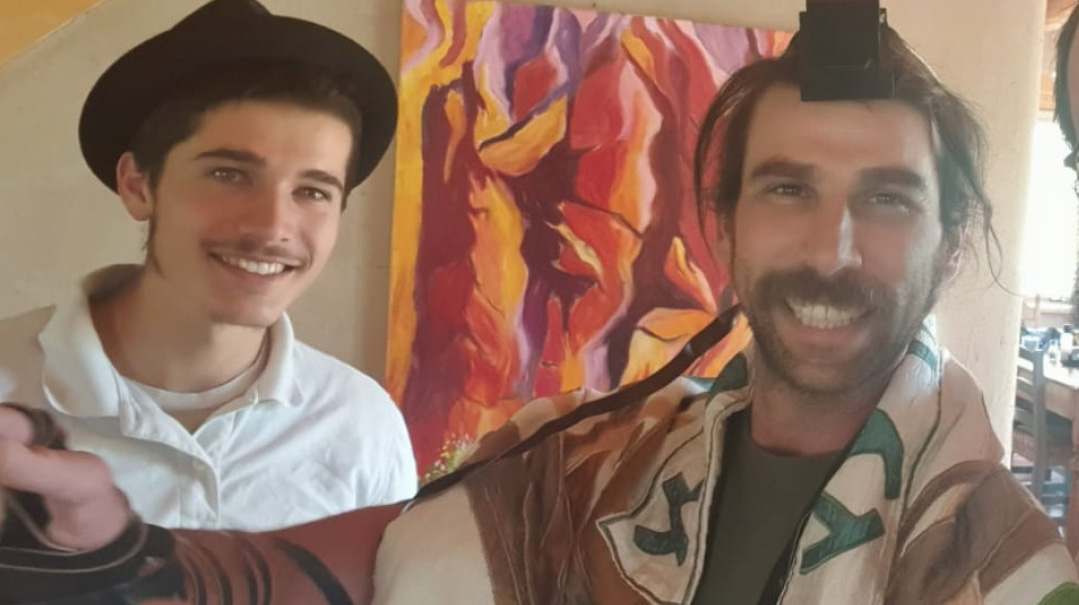Desert Flowers
| November 22, 2022We took a few pairs of tefillin to the mountains and deserts of northern New Mexico and discovered a world we never knew existed

Text and Photos: Jonah James
While the mountains and deserts of northern New Mexico aren’t exactly the top ten places of interest for Jewish travelers, we took a few pairs of tefillin and discovered a world we never knew existed: Jews who’ve never been to synagogue but can rattle off concepts in Kabbalah, an artist whose hundreds of paintings reflect Jewish tradition on the backdrop of the desert, and testimonies from crypto-Jews whose families have been hiding in these hills for centuries
The sprawling mountains of northern New Mexico aren’t on anyone’s list as a Jewish area of interest. But for two bochurim in a Hyundai Tuscon with a cracked windshield and a couple pairs of tefillin, it not only meant a month of outreach, but some unimagined discoveries deep within New Mexico’s remote villages.
Upon arriving in the historic tourist town of Taos, New Mexico (population 6,000), we soon realized that the Jews the local Chabad shaliach, Rabbi Eli Kaminetzky, meant for us to visit could not be found by maps, but rather through satellite coordinates, as they lived in private homesteads miles from civilization and often without another house in sight. This meant that many of the local Jews we’d come to visit were quite taken by surprise, seeing us standing outside their door with Shabbos candles and tefillin.

While some of these homesteaders haven’t been to synagogue in years, living on the cliffs has made them surprisingly spiritual. Yochai (right) and I make a new friend
Hushed Up
Having parked overlooking a canyon, our gas tank on empty, we exit the car and approach the cliffside residence. Sure enough, there’s a mezuzah on the doorpost, and a few moments later, an elderly man welcomes us inside with a hearty “Shalom!” He informs us that he and his wife, who recently began a chavrusa together and started keeping Shabbos, had not been to synagogue services for years. Traditional Judaism, however, reminds him of his days teaching history in a Jewish school in New York.
He then starts explaining to us some of the most esoteric concepts in Kabbalah, using Alef-beis permutation codes and gematrios to decipher the story of Adam and Eve, which only throw me further for a loop. I have to ask my friend and partner, Yochai Liberov, if I’m on a cliff in New Mexico or in a shtibel in Tzfas (he says the distinction appears thin). After an hour-long mystical dissertation, our new acquaintance asks us if we know anything about the crypto-Jews in these parts. We reply that we don’t.
“Oh, you spend enough time in these mountains, and you’ll hear about them,” he reassures us. “Folks whose ancestors got expelled during the Spanish Inquisition. They made their way to these parts, and have been living all in quiet for centuries. Didn’t tell nobody about their history though, but they married within the tribe all right, and kept up the customs. Good luck finding them, they’re called crypto-Jews for a reason. Always were hush-hush in case of persecution.”
I wondered how a community like he described could remain afloat for so long, with so little contact with outside Jewish life and so geographically remote.

Flight to Life
Apparently, once Christopher Columbus uncovered the “New World” for Europeans beginning in 1492, among the thousands of immigrants to settle in Spain’s Central American colonies were crypto-Jews fleeing the Inquisition, living lives on the outside as Catholics but practicing Judaism in secret, away from the prying eyes of the Inquisitors. Nevertheless, as we were to learn, all was not safe, as there were sporadic campaigns against Mexican crypto-Jews in the 16th and 17th centuries (by the time the Inquisition was abolished in Mexico in 1821, about 100 accused crypto-Jews had been put to death), and so, these crypto-Jews pushed on further to the northern frontier of Mexico and the more remote Spanish colony of New Mexico. In fact, according to records, of the first 19 families who founded Santa Fe 400 years ago, 11 of them were Jewish.
Still, we had our own mission to accomplish in these parts, searching out full-fledged Jews, so we put the man’s story on the back burner in the meantime.

“Young hippies have a fire that craves spirituality.” Not surprisingly, the entire group of Zen worshippers was Jewish
A Fire Inside
Later that week came a most troubling realization: After visiting house after house and meeting more of the locals, we became aware that all the homes we visited had two distinguishable features: either a mezuzah nailed neatly on the doorpost, or a large, rainbow Hindu shrine decorating the front yard. Indeed, we learned that the terms “Hindjew,” or interchangeably “Jewdhist,” are used to describe the phenomenon sweeping across the hills and mountains around Taos.
Any doubts were confirmed when we drove up a mountain one day and discovered a commune of Zenned-out Jews in the woods. While I was a bit nervous about interrupting their meditation session for a talk about G-d’s unity and the meaning of the soul’s descent into a body, I remembered a teaching of the Lubavitcher Rebbe, who once said that young hippies have a fire in them that craves real spirituality, and their nonconformity only affirms their distrust in society’s materialism. Not so surprisingly, the entire group was Jewish, and after learning that the dreadlocked boys never had a bar mitzvah, we put on tefillin with them. An older Jewish woman, weed-pipe in hand, then approached us upon hearing some familiar tefillos, and we asked her if she would like some Shabbos candles. She said yes, that she had not seen Shabbos candles for 40 years, and then she began to cry. She thanked us for the candles, and retreated back into the forest, as quietly as she had come. I wondered if she would ever light Shabbos candles again after using the pair we gave her, but even if not, I felt that she’d remember our interaction for a long time.
Our attention was diverted by a different elderly woman, this one covered head-to-toe in tattoos. She informed us that her mother was in fact Jewish, although she considered herself a devout Hindu and had changed her name to Annapurna, a mountain in Nepal. After offering us some free vegan food, which we declined, she then began sharing Rebbe Nachman of Breslov stories, which took us by surprise — although by this point, nothing could really faze me. After I tried capitalizing on the whole monotheistic element in the Rebbe Nachman stories (to little avail), she began inquiring if we had learned about the crypto-Jews. Upon hearing that we knew little about them so far, she said in an enigmatic whisper, “Oh, I’m sure you’ll meet them, if you know where to look.”

A spontaneous kumzitz and a bar mitzvah on the spot
Don’t Shoot
Rain is a classic feature of New Mexico summers, and in the backcountry, any semblance of roads can disappear within an hour due to flash floods. We holed up in the Hyundai until the storm cleared, thinking about and recuperating from our most recent home visit.
It had started off pretty standard: We had candles in one hand, tefillin in the other, and we were walking around to the side door of the house because the front was gated off. Suddenly, we heard a woman shouting from the window, “Hey! What are you doing on my property?!” to which we responded, “We’re Jewish students meeting local community members,” to which was met, “GET OFF MY LAND NOW!” We happily obliged, but as we walked back to the car, I was slightly unnerved by a clicking noise, which I soon realized was a shotgun pointed directly at my face. We bolted inside the car as the deranged lady continued pointing the semiautomatic at us. I ducked under the dash when she started focusing her aim, and Yochai slammed into reverse as we got out of there. Fortunately, no shots were fired, although I was quite shaken up.
As I processed what had transpired earlier that day, I focused on the Baal Shem Tov’s teaching that every single falling leaf is divinely orchestrated, and so too, the soul can descend into a body for 80 years just to do one act of kindness for another.
With these reinforcing messages, we steeled ourselves for the next house, and upon knocking on the front door, a man of about 30, with a flowing ponytail and a warm smile, welcomed us inside. The walls were covered with Southwestern watercolors, and two mild-mannered Schnauzers sniffed us out as we got acquainted with Eli. We learned that Eli played the guitar, so we joined him for a spontaneous kumzitz featuring some chassidic melodies he hadn’t heard before.
My partner Yochai, a skilled vocalist and cantorial enthusiast, began to sing “A Yiddishe Mamme,” and as he soared through the high notes in perfect pitch, I sat back and enjoyed the show, realizing that while Eli had probably never heard the vintage Yiddish classic, Yochai had transported him back to the shtetl — interrupted only by an extremely large rainbow parrot flapping wildly toward us. I ducked instinctively, while Eli assured us that there was nothing to be frightened of, that it was only the house parrot, and indeed, the specimen perched happily atop Eli’s arm as I questioned my sanity.
At this point, I realized we had farbrenged for two hours without putting on tefillin, and so we made a bar mitzvah for our avian-inclined friend right there on the spot. He was even excited about the prospect of spending Shabbos with us and learning some chassidus. We thanked him for his hospitality, and as we continued driving through the wilderness, I couldn’t get the parrot’s enormous wingspan out of my head. Animals would soon become a theme on our journey, as we learned that Native American rituals involving local wildlife were common in the region.
After off-roading through about five miles of overgrown farmland, we grew increasingly lost, and asked for directions from the only other person in sight — a man meditating in the middle of a field. We approached him, and naturally, we asked what he was meditating about. He said he had just seen a coyote, and that every time he saw a coyote he would compose a special prayer for the animal in honor of where it had walked. Though I found this ritual slightly odd, I now had a certain hunch about this man, who did not appear the slightest bit Native American. We learned he was indeed a Yiddishe neshamah who lived off the land after graduating a prestigious liberal arts college. While he refused our tefillin offer, he kindly assisted us in the right direction toward a house down a sloping valley, where an old Jewish woman had lived for decades.

The embers of a community teetering on extinction. How could they remain afloat for so long?
Like a Thousand Words
Upon hearing our car engine as we rolled onto the property, a massive four-legged creature emerged from under a rusting garage and began trotting toward us. Before we could evacuate the property, an elderly woman came hobbling toward us, yelling, “Don’t worry boys, that’s just my pet wolf-dog.” Horrified, we introduced ourselves as rabbinical students, and Diane, we learned, was only too eager to welcome us onto her porch; however, my safety still felt deeply threatened by her pet, which made a full-grown husky look diminutive. After convincing us the wolf-dog was friendly, she brought us cold water as she enthusiastically filled us in on her wind-chimes. We waved hello to her husband, who was busy strumming an aluminum banjo with a beer bottle, and asked Diane about her Jewish experiences in New Mexico. She said she liked to express her Jewish identity through art, and that she had a few paintings she’d like to show us in her studio. What followed far surpassed any of my expectations.
From floor to ceiling, hundreds of beautiful oil paintings covered the walls. There was a kaleidoscopic light that seemed to refract across the shed from the sheer quantity of artwork, and we knew we had stumbled across a master in her craft. As I gazed around the room in awe, I realized that every painting portrayed a Jewish scene backdropped against a New Mexican landscape. There was a black-hatted fiddler dancing on an adobe roof, a girl reciting Tehillim while coyotes howled behind her, and great bearded sages floating over the desert skyline.
Upon closer inspection, we noticed that the skin tone of many of her subjects reflected Spanish descent, and Diane informed us that she had an entire section of art devoted to the mysterious crypto-Jews: a mother and daughter lighting Shabbos candles in a closet, an aged abuelita rolling matzah dough, a woman lighting a menorah with the window shade intentionally closed, a shofar blown secretly in a wheat field.
There was obviously a far-reaching history in these mountains that reflected a community ardently attached to their ancestors, ancestors who brought their menorahs and tefillin aboard Christopher Columbus’ Santa Maria and who preserved their way of life on the subsequent ships that fled during the Spanish expulsion.
While almost impossible to verify the modern cryptos’ halachic Jewish status, Diane recommended we visit her friend Joan, who would be able to tell us more. We parted with a gift of Shabbos candles and tolerable feelings toward the wolf-dog, and left to meet Joan.
Joan proved to be a wealth of knowledge, and after procuring a “Rebbe dollar” [a dollar given by the Lubavitcher Rebbe to thousands who filed by on Sundays] from her wallet, much to our astonishment, she handed us a collection of poetry written by the area’s crypto-Jews. The poems were quite painful to read, brimming with inter-generational trauma and tight-roping identities that struggled to converge. They described childhoods in churches with souls that felt out of place, questions to G-d that invited more lonesomeness than resolution, and reflected the embers of a community that teetered on extinction. In fact, having spent their formative years in churches, crypto-Jews are considered to be especially receptive to messianic houses of worship that have popped up throughout the Southwest.
We saw photos of graves, with Spanish names written upon them in Hebrew, with Magen Davids and crosses side by side, and even hands with fingers split, a symbol of the Kohanim, etched in some of the stones. Their stories were tied together by a longing of the spirit, and I felt that a boundary had been crossed by becoming privy to such personal lamentations.

After we thanked Dennis for the produce, he remembered how he’d put on tefillin decades ago while on vacation in Italy
Deep Dive
Those feelings would be transformed into joy, however, after we met Dennis, an older gentleman who had not seen tefillin for 20 years. He lived completely off-grid in a two-story wooden cabin he built, and he invited us to his backyard where we sang a few niggunim and schmoozed. With my feet dangling in an icy river, sitting atop a tiny bridge, Dennis shared that his family hailed from the town of Poltava, so we couldn’t resist singing and teaching him the slow, soulful Poltava Niggun.
As the river seemed to flow with the niggun’s tenuah, our new friend informed us that it was an excellent stream for swimming, and that every morning, he would submerge for a few minutes for cardiovascular health. While I explained to Dennis the minhag of tevilah for added purity and that he was in fact more meticulous with it than I was, I wondered how he managed to stay under so long without freezing. Dennis explained that he was an ardent student of the Wim Hof breathing technique, a legendary method of controlled hyperventilation to withstand extreme temperatures. Eager to try it out, I was zocheh to have a tosefes taharah b’mesirus nefesh while Yochai went to help Dennis prune some plants in his large vegetable garden. Shivering, I emerged to a handful of snap peas and a bushel of lettuce thrust at me. After thanking Dennis for the produce, he told us he would like to put on tefillin, having doing it several decades ago when he met a shaliach on a vacation in Italy. We recited the brachos with him and continued on our journey.

Second Chance
While an aura of mystery may hover over the Southwestern desert, certain encounters seem particularly inexplicable. On Shabbos, as we walked across town after shul, the first thing that caught my attention was the “Shalom Aleichem” that came from outside the coffee shop. I turned, expecting to see someone with a hat and jacket, but instead we were greeted by a fellow with a jet-black ponytail down to his waist and a complexion somewhere between Native American and Spanish. Before I could even respond in kind, he pulled up two chairs for us to sit down. For some reason, I was sure this was going to be a serious farbrengen. The man, whose name we would never learn, began by stating in the most heimish inflection that he felt “an achrayus toward the Eibishter and Yidden” ever since a traumatic event occurred in his childhood.
He explained that when he was 12 years old, he had been standing near the edge of his school balcony taking in the 20-story view below. Somehow, a classmate bumped him and sent him flying off the roof to his doom. Upon such an impact, the only question remaining was the funeral date. But what he described next, with perfect sincerity and erudition, sent chills down my spine.
Indeed, he had died, but how did he know? “Well, when my 12-year-old self fell to the ground, the first thing I heard was an angel in Heaven saying, ‘Yehei Sh’mei Rabbah Mevorach,’ and at that point, I knew I had left this world. But in G-d’s great mercy, He gave me the choice to go back to the world, but only with great suffering. Immediately I said yes, and awoke in my body to unbearable pain, as both my legs had shattered, my ribcage had fractured, and a lung had collapsed. I fell into a coma, and after recovering, I thought about my eternal gratitude to the Almighty. One halachah I learned is that one shouldn’t throw bread to someone, even if that’s how he’s giving it to him. And that was my philosophy regarding Torah learning. I wasn’t going to take anyone’s free challah handouts. I’m going to teach myself Hebrew to investigate the emes myself, to learn the real chochmah so I can do teshuvah in my heart!”
At this point, I was unsure if I was witnessing nevuah or an acid trip — but I didn’t interrupt. Like a bochur straight out of 770, he then told us, “You know, it’s explained in chassidus, based on the Zohar, that the number eight is lema’ala min hateva [higher than nature]. That’s why my birthday is chaf-gimmel Adar, because it’s exactly eight days after Purim, where Hashem’s miracle was hidden in nature. So my whole existence is completely beyond nature, really.”
While I tried soaking in the chassidic discourse, he continued on, stating that in 1996 he experienced an extremely powerful dream where he knew that Mashiach had arrived, and he proceeded by describing the exact dimensions of Jaffa Gate and the Western Wall despite having never visited Israel. At this point, I stopped him just to clarify whether or not he was even Jewish. He said he couldn’t prove that he was, although he felt a deep connection to the Jews who escaped Spain and, increasingly, the descendants of Yisro. Normally, I would have shared the seven Noahide laws with him. However, I felt his Torah knowledge far surpassed mine. He then offered us to play a game of Mancala, which we refused, and we left equally inspired as awestruck, unsure which Kabbalist’s soul had reincarnated into his body.
In New Mexico, we realized that the best stories are there right in front of us, waiting to be told. It’s where the desert overtakes you in its enveloping expanse, and where the mountains stretch tall for their inhabitants to stay forgotten. But the light of inspiration seems to shine brighter here, and hopefully, it found its way through those peaks directly into the heart of at least one Jew we met. It’s where adventure unfolds right before our eyes, where all that’s left is to open them.
Jonah James is an English Literature and Political Science major at Yeshiva University, who spent last summer on Chabad’s “Merkos Shlichus” in northern New Mexico, where he met with dozens of Jews claiming ancestral ties to the Anusim from the Spanish Inquisition, Native American Noahides, and a woman whose family still has the original menorah allegedly passed down from Christopher Columbus’ ship.
(Originally featured in Mishpacha, Issue 937)
Oops! We could not locate your form.







